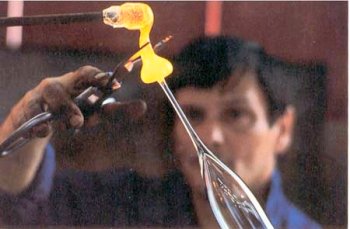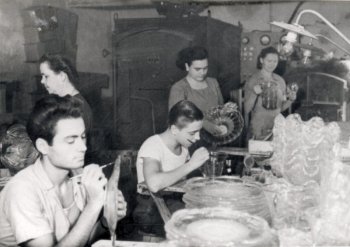
THE ITALIAN CRYSTAL COMES FROM COLLE VAL D'ELSA

95 percent of all Italian crystal comes from Colle Val D’Elsa, more than enough to define the town as the “ Bohemia of Italy”. There are four producer: Calp, Colle Cristallerie, Vilca and Duccio Di Segna which produces for the Arnolfo di Cambio brand. Total turnover in the sector armounts to 209 bilion liras and 810 people are employed.We mustn’t forget to mention the induced activities of cutters and engravers, craftsmen who decorate the final products, and moulds makers.
Calp ( the only one that inst’t menber of the Consortium ) is the largest of the four producers: it employs 720 employees and produces 60 milion pieces a year with a turnover of 183 bilion liras.
It all began in 1951 when the company “ Calb: Cristalleria-Artistica- Lavorazioni- Brevettate” was founded and began producing in February, 1952. “ Cristalleria La Piana S.p.A.” was founded in 1959 and then “ Calp, Cristalleria Artistica La Piana S.p.A.”, incorporating the production of Calb and Cristalleria “ La Piana”, was founded in 1967.
It moved to a brand-new factory in April 1970. The company exports its 4 brands ( Rcr, Primavera di cristallo, Da Vinci and Capri Crystal) all over the world.
While Calp works on industrial scale, the three other companies, all members of the consortium, produce on an essetially manual basis.
Arnolfo di Cambio, founded in 1963, currently comprises three companies: “ Di Cambio” for the brand; “ Compagnia Italiana del cristallo” for sales, and “ Duccio Di Segna” for production. It employs 31 people and invoices 8 bilio liras.
Colle Cristallerie, founded in 1960 as “ Kristal Krislla”, was taken over in 1992 by the Bormioli Group for niche production purposes. It employs 32 people, gives induced work to a further 14 and has a turnover of 14 bilion liras.
Vilca, established in 1960, is the only one produce on an exclusively menual basis. It employs 27 people, makes 160 tons of crystal a year, produces about 50,000 pieces, and invoices 4 bilion liras.
THE GLASS AND CRYSTAL MUSEUM OF COLLE

The glass and crystal Museum of Colle will open in a few mounths’ time. A special commission, set up by the Town Council of Colle di Val d’Elsa, together with experts in various fields, are now ironing out the final details.
First of all, I would like to underline how important this museum is for our town.
I think l’m right in saying that it represents pride, memory and gratitudine.
Pride, because all the citizens of Colle are prud of what the crystal of Colle means to the world.Memory, because no-one should forget the people who, from the outset to the present day, inventend, made and built, first in the field of glass and them in that of crystal.
Gratitude because it is partly thanks to glass and crystal that Colle has managed to create a strong idnetity for itself.
But what will we see inside the museum? By means of finds, pieces and extremely interesting documents, suitably classified using scientific criteria, visitors will be able to learn about the historical events connected with the glass of yesterday and the crystal of today.
They will be able to look iside a real furnace used to create this magical material. They will be able to admire unique pieces, specially reproducend from ancient drawings, objects that required authentic creative virtuosity in order to be made. Apart from that, visitors will be able to learn about the working techniques and touch the tools and implements of the “masters”. This parh of learning will be complemented with anecdotes and a glossary of the terminology used in this singular and fascinating world. A special section will be set aside for crystal that will be very suggestive for those who pass thorungh it.
But, just like a good book, it’s not right to reveal the plot and ruin readers’ enjoyment, and so I will say no more about this meseum for the benefit of future visitors.
I would just like to add that this museum will just be a point of departure as it will later break out of the walls that contain it and will grow all over the town, in specialised shops, in craft shops, in
worksops, in cutting shops ad in the factories where crystal is produced, in order to allow visitors to get a first-hand experience of what they learnt at the start of their journey into the world of crystal.
